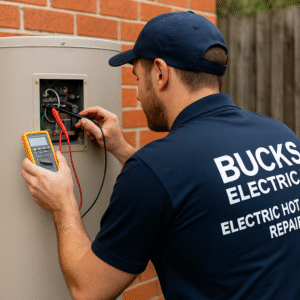The rise of smart home technology has revolutionized the way homeowners interact with their living spaces. From automated lighting and climate control to security systems and smart appliances, modern homes rely heavily on efficient and reliable electrical systems. However, many older homes were not designed to handle the increased electrical load and complex wiring demands of smart home technology. This is where electrical wiring upgrades become essential.
Upgrading your home’s electrical system ensures that your smart devices operate efficiently, safely, and reliably. In this blog, we’ll explore how modern electrical wiring upgrades support smart home technology, the benefits of upgrading, and the key considerations for homeowners looking to modernize their electrical systems.
Why Electrical Wiring Upgrades Are Important for Smart Homes
Smart home devices require stable power and consistent connectivity to function correctly. Without proper wiring, homeowners may experience:
-
Flickering lights when multiple devices are in use
-
Overloaded circuits that trip breakers
-
Reduced performance or connectivity issues in smart devices
-
Safety hazards such as electrical fires or short circuits
Modern electrical wiring upgrades address these issues by improving capacity, efficiency, and safety, allowing your smart home technology to operate seamlessly.
How Smart Home Technology Affects Electrical Demands
Smart homes often include a variety of devices that place additional demand on electrical systems:
-
Automated Lighting Systems: Smart bulbs, dimmers, and automated lighting schedules require consistent voltage.
-
Smart Thermostats: Energy-efficient climate control systems rely on stable power for sensors and wireless connectivity.
-
Home Security Systems: Cameras, sensors, and alarms need uninterrupted power to function reliably.
-
Smart Appliances: Refrigerators, ovens, washing machines, and other appliances integrated with smart technology draw higher loads and require modern circuits.
-
Voice-Controlled Devices: Hubs, smart speakers, and AI assistants require continuous connectivity and power.
Older homes with outdated wiring may struggle to support these systems, leading to performance issues and potential hazards.
Key Electrical Wiring Upgrades for Smart Homes
1. Upgrading Circuit Breakers and Panels
Older electrical panels may not have the capacity to handle multiple smart devices and high-powered appliances. Upgrading to a modern circuit breaker panel:
-
Increases overall electrical capacity
-
Allows for dedicated circuits for high-demand devices
-
Provides safety features like surge protection
With a properly upgraded panel, homeowners can install smart devices without worrying about tripping breakers or overloading circuits.
2. Installing Dedicated Circuits
Smart home devices often benefit from dedicated circuits to prevent interference and voltage drops. Examples include:
-
Smart lighting zones
-
Security cameras and alarm systems
-
Home office equipment and networking hardware
Dedicated circuits, installed during electrical wiring upgrades, ensure stable power delivery and reduce the risk of overloads.
3. Upgrading Wiring to Modern Standards
Many older homes have outdated wiring types, such as knob-and-tube or aluminum wiring, which may not safely support modern devices. Upgrading to modern copper wiring:
-
Handles higher electrical loads efficiently
-
Reduces resistance and energy loss
-
Increases safety and reduces fire risk
Modern wiring also supports faster and more stable connections for smart devices that require consistent power and network integration.
4. Installing Surge Protection
Smart devices are sensitive to voltage spikes and surges. Electrical wiring upgrades can include:
-
Whole-home surge protection
-
Individual surge protectors for critical devices
-
Ground fault circuit interrupters (GFCIs) in wet areas
These protections safeguard smart home systems, preventing damage to expensive electronics and appliances.
5. Enhancing Grounding Systems
Proper grounding is essential for safety and device performance. Upgraded grounding during electrical wiring upgrades:
-
Reduces interference and electrical noise
-
Protects smart devices from power surges
-
Enhances overall system stability
Smart devices, particularly networking hardware and automation systems, function more reliably with an effective grounding system.
6. Integrating Network and Low-Voltage Wiring
Smart homes rely on both high-voltage and low-voltage systems for:
-
Ethernet connections for data-intensive devices
-
Power over Ethernet (PoE) systems for cameras and sensors
-
Structured wiring for audio, video, and home automation
Upgrading electrical wiring alongside structured low-voltage cabling ensures that smart devices operate efficiently and communicate seamlessly across the home network.
Benefits of Electrical Wiring Upgrades for Smart Home Technology
1. Improved Reliability and Performance
Modern wiring reduces the likelihood of voltage drops, interference, and power surges, ensuring that smart devices operate reliably.
2. Enhanced Safety
Upgraded wiring decreases the risk of electrical fires, short circuits, and hazards associated with overloaded circuits.
3. Increased Home Value
Homes equipped with upgraded electrical systems and smart home technology are more attractive to buyers, increasing resale value.
4. Energy Efficiency
Proper wiring allows smart devices like automated lighting, thermostats, and appliances to function efficiently, reducing energy consumption and utility bills.
5. Scalability for Future Technology
Electrical wiring upgrades prepare your home for future smart devices, ensuring that your system can handle evolving technology without additional major upgrades.
Common Mistakes to Avoid During Electrical Wiring Upgrades
-
Not Planning for Device Load: Failing to calculate the total load of smart devices can result in overloaded circuits.
-
DIY Upgrades Without Expertise: Improper wiring or installation can create hazards and void insurance coverage.
-
Ignoring Surge Protection: Skipping surge protection leaves smart devices vulnerable to voltage spikes.
-
Neglecting Low-Voltage Wiring: Forgetting structured cabling for networking and home automation can lead to poor connectivity.
-
Overlooking Future Expansion: Not accounting for additional devices may require future rewiring, increasing costs.
Avoiding these mistakes ensures that electrical wiring upgrades provide maximum benefit for smart home technology.
Planning Your Electrical Wiring Upgrades
Step 1: Assess Current Electrical System
-
Check the age and condition of wiring and panels
-
Identify circuits that are overloaded or outdated
-
Determine the total electrical load required for smart devices
Step 2: Develop an Upgrade Plan
-
Decide which circuits need dedicated lines
-
Plan for surge protection, grounding, and structured cabling
-
Ensure compliance with local electrical codes
Step 3: Hire a Qualified Electrician
Working with a licensed professional ensures safe and code-compliant installation. A qualified electrician will:
-
Recommend the correct wire gauge and panel upgrades
-
Install dedicated circuits and surge protection
-
Integrate smart home technology wiring seamlessly
Step 4: Test and Verify
-
Measure voltage stability and current load
-
Verify that all smart devices function properly
-
Inspect grounding and safety features
Following this process ensures a successful and reliable upgrade.
Conclusion
Modern electrical wiring upgrades are essential for homeowners looking to fully integrate smart home technology into their living spaces. From improving reliability and safety to enhancing energy efficiency and future scalability, upgraded electrical systems form the backbone of any smart home.
By investing in proper wiring, dedicated circuits, surge protection, and grounding, homeowners can ensure that their smart devices operate efficiently and safely. For professional guidance, planning, and installation, partnering with experienced electricians at Madison Electric Company guarantees that your home’s electrical system is ready to support the latest smart home technology while providing peace of mind and long-term reliability.




